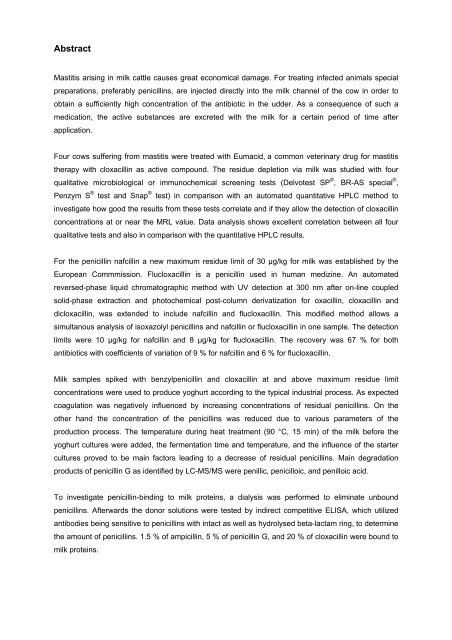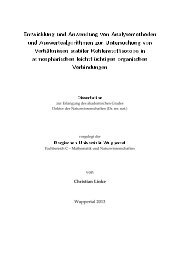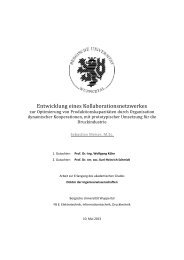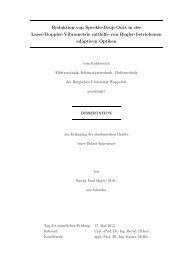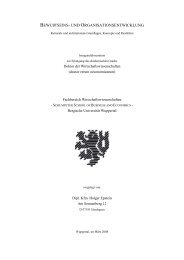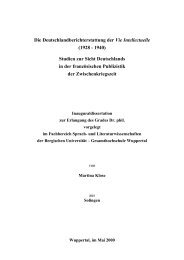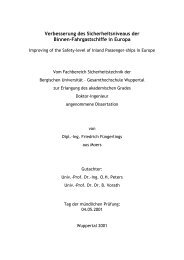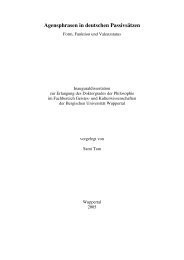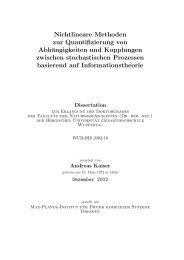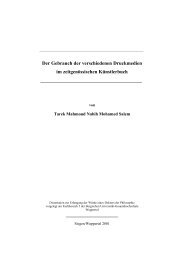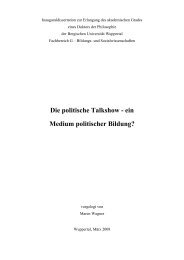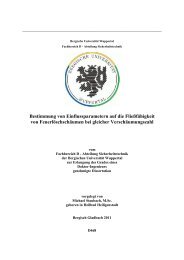Untersuchungen zur Analytik und zum Einfluss technologischer ...
Untersuchungen zur Analytik und zum Einfluss technologischer ...
Untersuchungen zur Analytik und zum Einfluss technologischer ...
Sie wollen auch ein ePaper? Erhöhen Sie die Reichweite Ihrer Titel.
YUMPU macht aus Druck-PDFs automatisch weboptimierte ePaper, die Google liebt.
Abstract<br />
Mastitis arising in milk cattle causes great economical damage. For treating infected animals special<br />
preparations, preferably penicillins, are injected directly into the milk channel of the cow in order to<br />
obtain a sufficiently high concentration of the antibiotic in the udder. As a consequence of such a<br />
medication, the active substances are excreted with the milk for a certain period of time after<br />
application.<br />
Four cows suffering from mastitis were treated with Eumacid, a common veterinary drug for mastitis<br />
therapy with cloxacillin as active compo<strong>und</strong>. The residue depletion via milk was studied with four<br />
qualitative microbiological or immunochemical screening tests (Delvotest SP ® , BR-AS special ® ,<br />
Penzym S ® test and Snap ® test) in comparison with an automated quantitative HPLC method to<br />
investigate how good the results from these tests correlate and if they allow the detection of cloxacillin<br />
concentrations at or near the MRL value. Data analysis shows excellent correlation between all four<br />
qualitative tests and also in comparison with the quantitative HPLC results.<br />
For the penicillin nafcillin a new maximum residue limit of 30 µg/kg for milk was established by the<br />
European Commmission. Flucloxacillin is a penicillin used in human medizine. An automated<br />
reversed-phase liquid chromatographic method with UV detection at 300 nm after on-line coupled<br />
solid-phase extraction and photochemical post-column derivatization for oxacillin, cloxacillin and<br />
dicloxacillin, was extended to include nafcillin and flucloxacillin. This modified method allows a<br />
simultanous analysis of isoxazolyl penicillins and nafcillin or flucloxacillin in one sample. The detection<br />
limits were 10 µg/kg for nafcillin and 8 µg/kg for flucloxacillin. The recovery was 67 % for both<br />
antibiotics with coefficients of variation of 9 % for nafcillin and 6 % for flucloxacillin.<br />
Milk samples spiked with benzylpenicillin and cloxacillin at and above maximum residue limit<br />
concentrations were used to produce yoghurt according to the typical industrial process. As expected<br />
coagulation was negatively influenced by increasing concentrations of residual penicillins. On the<br />
other hand the concentration of the penicillins was reduced due to various parameters of the<br />
production process. The temperature during heat treatment (90 °C, 15 min) of the milk before the<br />
yoghurt cultures were added, the fermentation time and temperature, and the influence of the starter<br />
cultures proved to be main factors leading to a decrease of residual penicillins. Main degradation<br />
products of penicillin G as identified by LC-MS/MS were penillic, penicilloic, and penilloic acid.<br />
To investigate penicillin-binding to milk proteins, a dialysis was performed to eliminate unbo<strong>und</strong><br />
penicillins. Afterwards the donor solutions were tested by indirect competitive ELISA, which utilized<br />
antibodies being sensitive to penicillins with intact as well as hydrolysed beta-lactam ring, to determine<br />
the amount of penicillins. 1.5 % of ampicillin, 5 % of penicillin G, and 20 % of cloxacillin were bo<strong>und</strong> to<br />
milk proteins.


